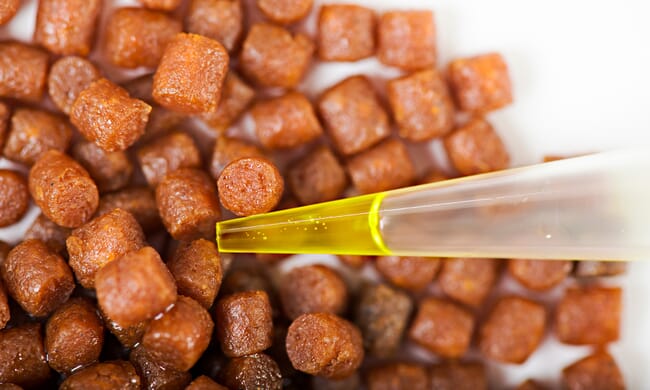The scientists, who work for Nofima, say that this finding is further evidence of the importance of marine fatty acids in Atlantic salmon diets.

They learned that a high content of DHA contributes to a redder fillet and fewer unwanted dark spots, so-called melanin spots. These spots need to be cut away on the filleting line and the fillet is sold at a lower price. This is the largest and most costly quality problem for the salmon farming industry.
Why omega-3 is important to research
The diet of farmed salmon has changed over several years. Around 70 percent of the ingredients in the feed come from the plant kingdom, whereas the feed used to be dominated by fish meal and fish oil. Therefore, the content of marine omega-3 has decreased over time.
To minimise negative effects of high plant content in the feed, scientists have investigated benefits of increasing the proportion of the marine fatty acids EPA and DHA. This is a joint effort in multiple projects led by Nofima, involving national and international research partners and industry.

© Nofima
These findings come from research with partners in the projects OptiHealth, SIS Balance and EX-spot, and has been financed by Norwegian Seafood Research Fund (FHF) and Research Council of Norway.
In short, the research projects show that there are good reasons to assure sufficient marine fat in the feed.
“We have known for a long time that omega-3 has an effect on colour. But which omega-3 fatty acid has an effect and how, this is new”, says Nofima’s omega-3 scientist Bente Ruyter.
The latest findings from Nofima indicate that the fatty acid DHA can enter the cells and regulate the synthesis of melanin.
When salmon get an inflammation of the muscle, immune cells called macrophages are attracted. These cells produce melanin, which causes dark spots in the fillet. Scientists have conducted cell experiments in which they gave DHA to macrophages isolated from the salmon, and initial trials show reduced melanin production in the cells.
Reduced dark spots
The effect of DHA is also evident in a trial in which salmon were fed a low (1 percent – 1.3 percent), medium (1.6 percent) and high (3.5 percent) content of marine fatty acids. The salmon that received a high content of marine fat had better fillet quality in terms of colour and a lower occurrence of dark spots.

In this trial, dark spots were significantly reduced with a high content of marine fatty acids. While only 8.6 percent of farmed salmon that received a lot of marine fat in their feed had dark spots, the corresponding figure was around 20 percent and higher for fish that received low and medium-high content.
Turid Mørkøre has been researching dark spots for a long time as a senior scientist at Nofima:
“We have now pointed out which fatty acid has the greatest inhibiting effect on dark spots. This is the long marine fatty acid DHA that reduces the occurrence of dark spots and gives a good red fillet colour”, says Mørkøre.
Several new sources may be the solution
Nofima has reported in previous research that if the proportion of marine fat is around 1.6 percent of the feed, it is considered safe for the fish. So far, little has been known about the benefits of including more than 2 percent in the feed. However, the scientists can now answer this question. Salmon that received 3.5 percent marine fatty acids in their feed throughout the entire sea phase in net-pens had significantly better growth, welfare, robustness and fillet quality compared to salmon that received 1–1.6 percent in their feed.
“Our findings underline the importance of marine fats in maintaining good growth, robustness, welfare and fillet quality in salmon farmed in net-pens”, says Ruyter.
Does this mean that more DHA should be added to salmon feed?
“Yes. There are so many trials that show the positive effect of going higher than 1.6 percent, so we are reasonably confident that this is a good recommendation. The aquaculture industry has understood this, and as far as I know, the level of marine omega-3 is already well above 2 percent in commercial feed”, says Ruyter.
Ruyter emphasises that marine fatty acids must not necessarily originate from fish oil. There are currently alternative sources of DHA that are suitable, and more are being developed by industry and researchers. Examples of such sources are microalgae, krill or genetically modified plants.




